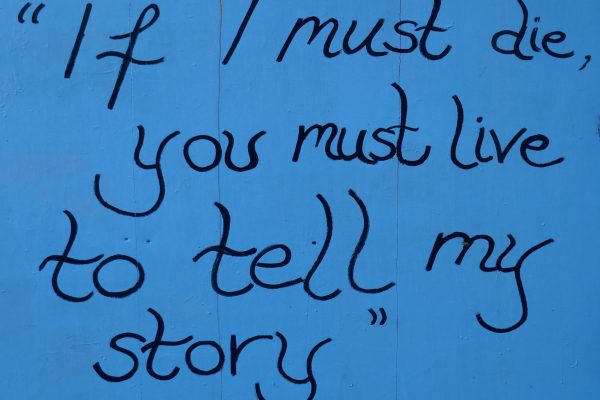What is the ethical power of literature? Can it diminish acts of injuring, and if it can, what aspects of literature deserve the credit?
All these questions, at first, hinge on another: can anything diminish injury? In his recent book The Better Angels of Our Nature, Steven Pinker argues that, over 50 centuries, many forms of violence have subsided.1 Among the epochs he singles out for special scrutiny is a hundred-year period bridging the seventeenth and eighteenth centuries during which an array of brutal acts—executing accused witches, imprisoning debtors, torturing animals, torturing humans, inflicting the death penalty, enslaving fellow human beings—suddenly abated, even if they did not disappear.
Attempting to account for “the sweeping change in everyday sensibilities” toward “the suffering in other living things” and for the protective laws that emerged during the Humanitarian Revolution, Pinker argues that the legal reforms were in some degree a product of increasing literacy. Reforms were immediately preceded by a startling increase in book production (e.g., in England, the number of publications rose from fewer than 500 per decade in 1600 to 2,000 per decade by 1700, and to 7,000 per decade by 18002) and by an equally startling surge in literacy, with the majority of Englishmen literate by the end of the seventeenth century, French by the end of the eighteenth, and Danish, Finnish, German, Icelandic, Scottish, Swedish, and Swiss by the end of the nineteenth century.3
Pinker singles out one particular form of reading and one particular kind of book—the novel—though, as we will see, features of poetry that long predate the novels of this period are essential to literature’s capacity to reduce harm. Drawing elaborately on the work of historian Lynn Hunt, Pinker convincingly describes the effect of men reading best-selling novels such as Richardson’s Pamela and Rousseau’s Julie and thereby entering imaginatively into the lives of other people, including those without social power: women, servants, and children.4 Pinker gives a picture of human mental life before and after the literacy revolution:
The pokey little world of village and clan, accessible through the five senses and informed by a single content provider, the church, gave way to a phantasmagoria of people, places, cultures, and ideas.5
If we assume (on the basis of very incomplete evidence) that literature has in fact helped to diminish acts of injuring—not only during the Humanitarian Revolution, but also in other epochs—what attributes of literature can explain this? Three come immediately to mind: its invitation to empathy, its reliance on deliberative thought, and its beauty.
Because empathy is so fundamental to literature, it has been defended, doubted, berated, and celebrated countless times. And though it deserves to be examined countless times more, I will not dedicate space to it here except to note the following.
By “empathy” Hunt and Pinker—rightly in my view—mean not the capacity of literature to make us feel compassion for a fictional being (though literature certainly does this), but rather the capacity of literature to exercise and reinforce our recognition that there are other points of view in the world, and to make this recognition a powerful mental habit. If this recognition occurs in a large enough population, then a law against injuring others can be passed, after which the prohibition it expresses becomes freestanding and independent of sensibility.6 Literature says: “Imagine Pamela, and her right to be free of injury will become self-evident to you.” The laws say: “We are not interested in your imaginative abilities or disabilities; whether or not you can imagine Pamela, you are prohibited from injuring her.”
The novel’s capacity to evoke readers’ empathy has antecedents. It was anticipated by the second attribute of literature that works against injury: the deliberative push embedded in poetry.
The connection of poetic composition to deliberation—to the “pro” and “con” of debate—is in the very first description we have of the muses singing, the one Homer gives at the close of the first book of the Iliad. Thomas Hobbes, who was acutely interested in deliberation, writes in his 1676 translation, beginning with the feasting of the gods, “And all the day from morning unto night / Ambrosia they eat, and nectar drink. / Apollo played, and alternately / The Muses to him sung.” The alternating voices of the Muses are audible in Alexander Pope’s later translation,7 as in John Ogilby’s earlier one.8 Ogilby’s annotation9 to the lines states: “The Muses sung in course answering one the other . . . Anthem-wise; [the Greek Homer uses] being such Orations as were made pro and con upon the same argument.” He then invokes Virgil’s Eclogue, “The Muses always lov’d alternate Verse” and Hesiod’s Theogony, “Muses begin, and Muses end the Song.” The argumentative structure enacted by Homer’s Muses is registered in every English translation, with the exception of George Chapman’s. Samuel Butler writes, “The Muses lifted up their sweet voices, calling and answering to one another”; in Richmond Lattimore’s edition we read of the “antiphonal sweet sound of the Muses singing”; and Robert Fagles has the “Muses singing / voice to voice in chorus.”10
The Iliad is an epic ignited by the dispute between Achilles and Agamemnon, and we are more likely to associate dispute with epic poetry or with plays, as in the drama contests of fifth-century Greece. But many other genres of poetry have the debate structure built into them, as we can see by the word “anthem”—derived from “antiphone” or “verse response”—which surfaces in the translations. That an anthem, or hymn of praise, holds disputing voice within it reminds us that there is nothing anti-lyric about this deliberative structure.
Many styles of poetry bring us face to face with acts of deliberation. The eclogue is a dialogue poem about the act of choosing, as in Virgil’s Third and Seventh Eclogues when a judge is asked to choose between the arguments of two shepherds. The word “eclogue” is derived from eklegein, meaning, “to choose.”11 Another example is the tenzone, in which two poets argue “in alternating couplets,” as Urban Holmes describes in Princeton Encyclopedia of Poetry and Poetics.12 The tenzone eventually took on other forms, such as the partimen or jeu parti, in which one “poet proposes two hypothetical situations.” One of the positions is then defended by that poet and the other by a second poet, each speaking in three stanzas.13 And in his translation of Dante’s Vita Nuova, Mark Musa explains, “The Italian troubadours invented the sonnet form [of the tenzone], still a mode of debate in which the problem is set forth in a proposta inviting a risposta (using the same rhymes) from another poet.”14
While in the tenzone two distinct sonnets are placed in dispute, an oppositional mental act is also interior to the sonnet itself, particularly in the Petrarchan form with its division into an octave and a sestet. While the volta, or “turn of thought,” is most emphatic in the Petrarchan form, it is also recognizable in Spenserian and Shakespearean sonnets15
Holmes directs attention not only to the poetic forms just enumerated but to others that entail a contest structure, such as the lauda, which calls for “responsive participation” and hence for dialogue, as well as the pastourelle, in which an aristocrat or knight attempts to seduce a shepherdess and is often outwitted by her or by her fellow shepherds.16
The inseparability of poetic and disputational thinking is registered in the titles of many Middle English poems: “Parlement of Foules,” “Parliament of Devils,” “Parliament of the Three Ages,” “Dialogue between Poet and Bird,” “The Cuckow and the Nightingale,” “The Thrush and the Nightingale,” “The Owl and the Nightingale,” “The Clerk and the Nightingale,” “The Floure and the Leafe,” “Dispute between the Violet and the Rose,” “The Holly and the Ivy,” “The Debate of the Carpenter’s Tools,” “Wynnere and Wastoure,” “Ressoning betuix Aige and Yowth,” “Ressoning Betuix Deth and Man,” “Death and Liffe,” and, last but not least, “A Disputacion betwyx the Body and Wormes.”
Medieval debate poems occur in many languages, starting with the eighth-century Carolingian poem “Conflictus Veris et Hiemis.” John Edwin Wells, an early twentieth-century scholar of Middle English, notes that versions of the “Debate between Body and Soul,” which first occurs in English between 1150 and 1175, “are extant in Latin, Greek, French, Provençal, German, Dutch, Spanish, Italian, Danish, and English.”17
There are also parallels in the Eastern tradition. Titles in Sumerian, Akkadien, Assyrian, and Babylonian poems often resemble those above: “Summer contra Winter,” “Bird contra Fish,” “Tree contra Reed,” “Silver contra Leather,”18 “Copper vs. Leather,” “Ewe vs. Wheat,” “Herdsman vs. Farmer,” and “Hoe vs. Plough.”19 Describing ancient Near Eastern dispute poems as “tools and toys at the same time,” Herman Vanstiphout argues that a serious lesson is at the center of these poems: “All coins have two sides.”20 Much later English counterparts share this lesson. Thomas L. Reed shows that although many Anglo-Saxon and Middle English poems feature a “right” position to which the wrong thinker can be converted, in many others the disputants are equals and no final decision is made.21
Reed demonstrates that in addition to all of the explicitly titled dispute poems, many of the major English works are debates: Beowulf with its “sparrings” and formal flytings;22 Piers Plowman with its wayward and “enigmatic” path; Sir Gawain and the Green Knight with its disputations between green and gold, winter and summer, Christianity and chivalry, youth and age, sinner and mercy, discourtesy and treachery.23 The Canterbury Tales also features a “debate on marriage” extending across the tales of the Merchant, the Clerk, the Wife of Bath, and the Franklin; the “flytings” between Reeve, Miller, Summoner, and Friar; and the overall “narrative competition” among the taletellers to be judged by Harry Bailly.24
In their own time, these poems helped to give rise to new civic institutions in which disputation was carried out obsessively. Thomas Reed and Howard Bloch show the intimate connection between the “unprecedented burgeoning” of poetic disputation in the twelfth through fifteenth centuries and the simultaneous growth of three institutions: the universities, where disputation, in the forms of logic and dialectic, dominated the liberal arts;25 the courts of law and the accompanying law school–like Inns of Court, where law cases and legal questions were debated in sessions called “doubts and questions,” “mootings,” and “boltings”;26 and the Parliament, with its assembly structure and roll call votes.27
Just as, then, Pinker and Hunt see the sudden rise of literacy, publishing, and the novel as instigating (or at least assisting) the legal reforms that together form the Humanitarian Revolution in the eighteenth century, so the dispute structure of poetry from Homer forward helps to nourish three arenas of disputation in the twelfth and thirteenth centuries whose purpose—at least in the parliaments and law courts—is diminution of injury.28
What does a dispute among the muses, or between Achilles and Agamemnon, or between Sophocles and Euripides, or between two shepherds, or between a plough and a hoe, or between a rose and a violet, or between an owl and a nightingale have to do with the empathy we experience in reading Clarissa or Moll Flanders or Emma?
In fact the claims made about dispute greatly resemble what we can say about empathy. What they have in common is not just the recognition that there are multiple points of view, two sides to every coin, but also the chance to practice, and thereby to deepen and strengthen that recognition.
More important, both dispute and empathetic narrative require one to think counterfactually, to think the thing that one does not oneself hold to be the case. In a dispute, one side’s argument may strike us as true, factual; the other side’s strikes us as untrue, hence counterfactual. But we attend to both. If we imagine a dispute poem becoming a novel, all that has happened is that the factual side has fallen away and we are presented only with the counterfactual. Another way to say this is that in a dispute poem, the side one already believes in (let’s say, the side of the rose) can be understood as just a narrative excuse for introducing the side one does not believe in (the side of the violet). By the time of fiction, the need to lure one into the violet’s story by providing the reassuring presence of the rose has dropped out. We are just given the counterfactual from start to finish.
The third attribute of literature that contributes to the diminution of injury is its beauty. In this case, the reader herself may be the beneficiary; it is the reader’s own injuries that are diminished since—at least according to Walter Pater—reading extends her life. Pater observes that we cannot actually change how long we live, but we can effectively do so by “getting as many pulsations as possible into the given time.” Beautiful artworks and poems are, according to Pater, the surest way to bring about “this quickened, multiplied consciousness” and hence to fold 200 (or perhaps 2,000) years of perception into an ordinary lifespan, which in Pater’s case was 55 years.29
But though the ethics of reading can surely include the benefits to the reader herself, our focus here is on the way other, often unknown, persons are the beneficiaries of one’s reading. There are at least three paths by which beauty contributes to this outcome.30
First, beautiful things (whether poems, mathematical equations, or faces) have attributes—such as symmetry, vivacity, unity—that anticipate those same, but much more difficult to achieve, attributes in the realm of justice. Symmetry is at hand in, for example, the meter of a poem, and provides inspiration and guidance for the centuries it will take to bring about symmetry in the realm of justice—whether it is John Rawls’s justice as fairness, which requires “the symmetry of everyone’s relations to each another”; or Plato’s aspiration for a symmetry between crimes and punishments, which we are still a very long way from; or Hume’s symmetry between expectations and their fulfillment.
Second, beauty interrupts and gives us sudden relief from our own minds. Iris Murdoch says we undergo “an unselfing” in the presence of a beautiful thing; “self-preoccupation” and worries on one’s own behalf abruptly fall away. Simone Weil refers to this phenomenon as a “radical decentering.” I call it an “opiated adjacency,” an awkward term but one which reminds us that there are many things in life that make us feel acute pleasure (opiated) and many things in life that make us feel sidelined, but there is almost nothing—except beauty—that does the two simultaneously. Feeling acute pleasure at finding oneself on the margins is a first step in working toward fairness.31
Contact with the beautiful has one additional effect. Diotima tells Socrates who tells Plato who tells us that coming into the presence of a beautiful person or thing gives rise to the desire to bring children into the world. Diotima says contact with the beautiful also gives rise to the desire to create poems, legal treatises, and works of philosophy. Modern philosophers such as Wittgenstein have said the same. Recognizing our own capacity for creating is again a prerequisite for working for justice: while beauty can be either natural or artifactual, justice is always artifactual; it always takes immense labor to bring it about. So anything that awakens us to our own power of creation is a first step in working to eliminate asymmetries and injuries.
Literature may be able to diminish real-world injury, and the three attributes of literature—empathy, dispute, beauty—can, perhaps, be credited with that outcome.
Let us imagine we can do away with hesitation and affirm the open-and-shut truth of these propositions. The next question would be whether literature does its beneficial work on its own, across a diffuse, population-wide terrain, or whether its beneficent effects are accelerated by intensely individualized, person-by-person instruction. In other words, need one actively cultivate literature’s curative powers?
From everything that has been said so far it seems clear that shifts in ethical behavior require a sea change across wide populations of readers. This means, as we have long known, that the main work of the humanities is to ensure that books are placed in the hands of each incoming wave of students and carried back out to sea. Probably, though, teachers and readers need to do more. We should give more attention to making clear the lines of responsibility to real-world injuries and the call to that work that is embedded in the three key features of literature. For even if changes in sensibility will occur without instruction or explicit intervention, less mystification and more clarity might make it easier for people to find their way.
Finally, while changes in sensibility work by being widely distributed and widely shared, it would no doubt be useful to remind new readers about the changes solitary readers have made. It is clear that uniquely avid individual readers have, from time to time, made magnificent solo contributions to the diminution of injury. Daniel Defoe, the originator of the English novel, also helped originate the idea that constitutions must be written, as the legal scholar Bernadette Meyler has argued persuasively.32 The novel Julie—one of the best-selling novels with which we began—was written by Rousseau, the author of the Social Contract. Hobbes, whose Leviathan has as its central goal “getting us out of the miserable condition of warre,” read the Iliad often enough and rigorously enough to translate all 16,000 lines, as he also read the Odyssey enough to translate that poem. And if, with the help of J.R. Madicott’s The Origins of the English Parliament 924–1327, we look not at the flourishing of Parliament in the twelfth through fourteenth centuries, but at the origination of that institution, we arrive at Æthelstan, the first king of England, in the early tenth century. He turned what in earlier reigns had been an ad hoc procedure of occasionally consulting advisors into a formal, regular assembly that witnessed and approved charters and laws.33 Æthelstan was known for his book collecting, his learning, and for the poems that emerged from his court (including, it seems probable, De arte metrica, a treatise on poetry written in verse). There is evidence, though far from conclusive, that Beowulf was written in his circle.34 “The quantity of poetry to survive from this reign,” biographer Sarah Foot writes, “suggests that poetry recitation may have formed a part of evening entertainment at his court.”35
No matter how loyal and unswerving one’s personal and public commitments—to a love partner, a country, an idea—part of our interior remains capable of change. It is this part of our interior—this region of reversibility that is like a sheet of spun fabric one nanometer thick—that literature addresses. Far from being a threat to our commitments, this interior silk fabric that makes us labile and open enables us actively to re-consent each day to the people and places we are ever more deeply committed to. It also makes us open to new commitments. All genres of literature address this part of us: that is why anti-theatrical tracts are so frightened of the theatre; that is why it is impossible to predict which fictional person any one of us will identify with when reading Antony and Cleopatra or Wuthering Heights.
But it’s not just that literature addresses this counterfactual fabric, this honeycombed pliancy within one’s thoughts and spirit. It’s that literature—centuries of literature—has created it, or at least enabled it to remain intact even after we are old enough to have become “completed” persons.36






